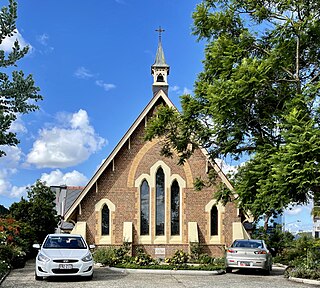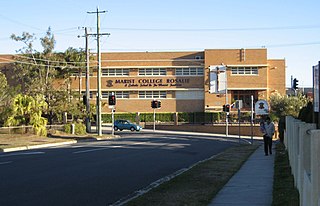
The Holy Name Cathedral was a planned but never-built Roman Catholic cathedral for the city of Brisbane, Queensland, Australia. Designed by Hennessy, Hennessy & Co, initially in an English Baroque style inspired by St Paul's in London, it was intended to have been the largest church building of any Christian denomination in the Southern Hemisphere. James Duhig, the Archbishop of Brisbane, was the chief proponent of the project.

The Cathedral of St Stephen is the heritage-listed cathedral church of the Roman Catholic Archdiocese of Brisbane and seat of its archbishop in Brisbane, Queensland, Australia. St Stephen's was only meant to serve as a temporary seat for the archbishop, and plans for a replacement were made with the Holy Name Cathedral, however the cathedral was never built.

The second St Mary's Roman Catholic Church is a heritage-listed sandstone Catholic church at 163 Palmerin Street in Warwick in the Southern Downs Region, Queensland, Australia. It was designed by Dornbusch & Connolly and built from 1920 to 1926. It is also known as St Mary of the Assumption Church. It was added to the Queensland Heritage Register on 21 October 1992.

St Patrick's Church is a heritage-listed Roman Catholic church at Rosewood - Aratula Road, Rosevale, Scenic Rim Region, Queensland, Australia. It was designed by Father Andrew Horan and built from 1888 to 1889. It was added to the Queensland Heritage Register on 11 December 2009.

Goldicott is a heritage-listed house, set on 1.23 hectares, located at 50 Grove Street, Toowong, Brisbane, Queensland, Australia. It was built from 1885 to c. 1918.

St Thomas' Anglican Church is a heritage-listed church at 69 High Street, Toowong, City of Brisbane, Queensland, Australia. It was designed by Francis Drummond Greville Stanley and built in 1877 by Henry Pears. It was also known as St Thomas' Church of England. It was added to the Queensland Heritage Register on 21 October 1992.

John Francis (Jack) Hennessy (1887–1955) was an Australian architect, with the same name as his architect father, John Francis Hennessy, with whom he was in partnership as Hennessy & Hennessy from 1912 to 1924. As principal of the firm after his father retired from 1924 to 1955, he was responsible for many major Art Deco office buildings in capital cities in Australia and New Zealand in the 1930s, as well as many projects for the Catholic Church in Queensland, and the Great Court of the University of Queensland.

St Mary's Church is a heritage-listed Roman Catholic church at 20 Merivale Street, South Brisbane, Queensland, Australia. It was designed by Simkin and Ibler and built from 1892 to 1929. It was added to the Queensland Heritage Register on 3 December 2004.

Our Lady of Victories Church is a heritage-listed Roman Catholic war memorial church at 29 Cintra Road, Bowen Hills, City of Brisbane, Queensland, Australia. It was designed by Hall & Prentice and built from 1919 to 1962. It is also known as White Temple of Peace. It was added to the Queensland Heritage Register on 11 November 1996.

Nazareth House is a heritage-listed benevolent institution at 272 Wynnum North Road, Wynnum, City of Brisbane, Queensland, Australia. It was built from 1924 to 1939. It was added to the Queensland Heritage Register on 2 April 2002.

St Patrick's Church is a heritage-listed Roman Catholic church at 58 Morgan Street, Fortitude Valley, City of Brisbane, Queensland, Australia. It was designed by Andrea Giovanni Stombuco and built from 1880 to 1882 by John Arthur Manis O'Keefe. It was added to the Queensland Heritage Register on 21 October 1992.

Villa Maria Hostel is a heritage-listed nursing home at 167–173 Saint Paul's Terrace, Fortitude Valley, City of Brisbane, Queensland, Australia. It was designed by Frank Cullen, Hennessy, Hennessy, Keesing & Co, & J P Donoghue and built from 1927 to 1968. It was added to the Queensland Heritage Register on 18 September 2008.

Corpus Christi Church is a heritage-listed Roman Catholic church at 65 Bage Street, Nundah, City of Brisbane, Queensland, Australia. It was designed by Hennessey, Hennessey, Keesing and Co and built from 1925 to 1926 by Stanley Samuel Carrick. It was added to the Queensland Heritage Register on 6 July 1995.

Bulolo Flats is a heritage-listed apartment block at 9 McLachlan Street, Fortitude Valley, City of Brisbane, Queensland, Australia. It was designed by Hennessey, Hennessey & Co and built in 1934 by P H Turner & Co. It was added to the Queensland Heritage Register on 13 November 2008.
Hennessy & Hennessy was an architectural firm established in 1912 in Sydney, Australia that was responsible for a series of large scale office buildings in the 1930s in all capital cities in Australia, as well as New Zealand and South Africa, designed by John (Jack) Hennessy (1887–1955), described as Australia's first international architect.

St Patrick's Church is a heritage-listed Roman Catholic church at Church Street, Gympie, Gympie Region, Queensland, Australia. It was designed by Francis Drummond Greville Stanley and built from 1883 to 1935. It was added to the Queensland Heritage Register on 20 February 1995.

Our Lady Star of the Sea Church & School is a heritage-listed Roman Catholic church and school at Goondoon Street, Gladstone, Gladstone Region, Queensland, Australia. It was built from 1924 to 1950. It was added to the Queensland Heritage Register on 21 October 1992.

Marist Brothers College Rosalie Buildings are heritage-listed Roman Catholic monastery and school buildings at Fernberg Road, Rosalie, City of Brisbane, Queensland, Australia. They are also known as Marist Brothers' Monastery and Marist College. They were added to the Queensland Heritage Register on 18 September 2008.

St Peter and Paul's Old Cathedral is a heritage-listed former Catholic cathedral and now parish church at 42 Verner Street, Goulburn, Goulburn Mulwaree Council, New South Wales, Australia. It was designed by Andrea Stombuco and Charles Spadacini and built from 1871 to 1890 by C. J. O'Brien and Wilkie Bros. It is also known as St. Peter and Paul's Former Cathedral and St Peter and Paul's Catholic Cathedral; Saints Peter and Paul's Catholic Cathedral. It was added to the New South Wales State Heritage Register on 20 April 2009.

Mary Immaculate Church is a heritage-listed Roman Catholic church located on the corner of Ipswich Road and Ferndale Street, Annerley, a suburb of Brisbane, Queensland, Australia. Mary Immaculate Church is located in the Archdiocese of Brisbane and is under the care of the Brisbane Oratory in Formation, a Congregation of the Oratory of St. Philip Neri.





















